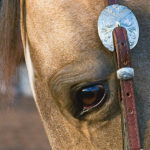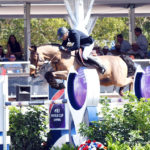In dressage, we often talk about the seat. This is more than just the flesh under our seat bones. It includes our whole torso. When it comes to riding, we need good control of our torso to help keep the spine, ribs and pelvis evenly stacked. When the body can hold itself up, in a similar way as a horse has self-carriage, it helps create a light seat.
Because of wear and tear and bad postural habits, often some muscles need to be tightened and some need to be lengthened to create balance. Equal movement in all planes, that is forward (flexion), back (extension), sideways (lateral flexion) and rotation, will help bring about evenness. Let’s look at these in stages to see what we can do to create correct posture and good and even strength in all directions.
Think of your torso as a big cylinder. When you ride, although you don’t want the cylinder to move, the tension within the cylinder will be changing and making small adjustments constantly. For example, if you require your horse to move forward more (driving aids), the feeling is that the contents of the cylinder push from the back to the front and vice versa if you want your horse to come back (half or full halt). We need to teach the body to first stabilize and then hold that stability when we start altering the “pressure” within the cylinder, moving our limbs (useful when we need to give leg or rein aids) or when we start being moved by the horse, especially one with a big stride.
Strengthening and evening out the muscles of the torso means that the rider is less likely to clamp on with her legs or hold with her hands and use them to balance. As an exercise on the horse, at the walk, stretch your legs down and lift them off the horse from the hip joint. Feel your seat bones sink into the saddle and feel how your torso reacts and balances you as the horse moves. Do you fall forward or back or favor one side or the other? This will give you some insight to your misalignments.
This month we will look at exercises that focus mainly on the front of the body. Just like when teaching our horses to execute movements correctly, we need to execute our exercises correctly each time so that the neuromuscular pathways can be developed and correct movement can become good habit. For that reason, form should always trump the number of repetitions. Build yourself up slowly.
Hundreds
This will help you activate your transverse abdominis, stabilize your rib cage (by rolling up your head and neck) and get you nicely warmed up.
Setup:
• Lie on your back and find your neutral pelvis. Roll your head and neck up off the ground—don’t come up too high— by sinking your upper abdominals into the floor. If you feel too much strain in your neck, just keep your head rested on the ground.
• Stretch your legs away from your body and stretch your arms forward. If this position is too strong and you feel your back being pulled off the floor, either take your legs higher, bend your knees 90 degrees or leave your feet on the ground with your knees bent.
• Add lateral breathing.
• Switch off global muscles: legs and arms, and switch on your core.
Performing the Movement:
Engage your abs to keep your upper body lifted as you beat your arms 100 times, keeping your shoulders drawn down your back. Keep your arms shoulder-width apart so you don’t narrow your chest. While you are in this position, breathe in through your nose for five beats and breathe out through your mouth for five beats.
Flat Back on Ball
This teaches your abdominal muscles to support your back with your torso in a dressage position.
Setup:
• Find your neutral spine while kneeling, resting your hands against a fitball.
• Add lateral breathing.
• Switch off your legs and arms, switch on your core.
Performing the Movement:
• Breathe in and hinge forward from your knees, rolling the ball under your lower arms. Make sure you keep a straight line in your body from knees to head, and don’t let your butt stick out behind. Only hinge forward as much as your abs are able to support your back. Keep your chest lifted so you don’t just throw all your weight into your arms and hunch your upper body. Keep your legs relaxed.
• Breathe out and return to start position.
Roll Up on Ball
The ball will ensure that you are really drawing your abs in toward your spine as your rectus abdominis rolls you up and that you are not just bracing outward with your transverse abdominis (core–stabilizing muscle). If you do it slowly, you will really improve your motor control, helping to make small adjustments possible.
Setup:
•
Lie over the ball with your spine in extension and with your hands behind your head to support your neck. Only go as far back as you feel comfortable.
• Add lateral breathing.
•
Switch off your legs, including your hamstrings and calves, and your arms, and switch on your core.
Performing the Movement:
•
Starting with your head and neck, breathe out and roll up one vertebra at a time, pressing your back gently into the ball and your abs into your spine. Keep the movement even so as not to favor one side of your body over the other. Remember, this is an ab exercise, so don’t use your shoulders to help you up.
• Breathe in.
•
Breathe out to roll back down, one vertebra at a time.
Rebecca Ashton is a qualified Pilates instructor, a British Horse Society-trained instructor and an Equestrian Australia-accredited dressage coach. She has competed through Intermediaire II, working with riders such as Anky van Grunsven and earning championship titles in the small tour. She lives in Australia and teaches clinics internationally (equestelite.com).






